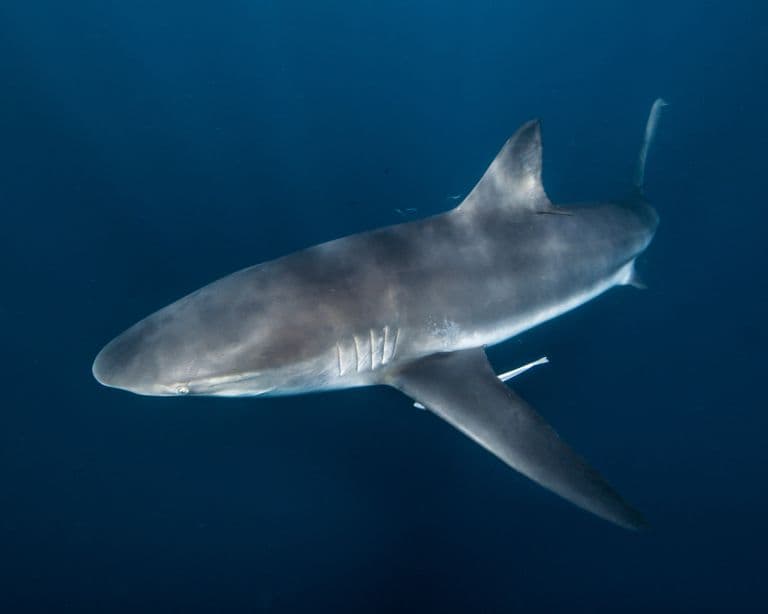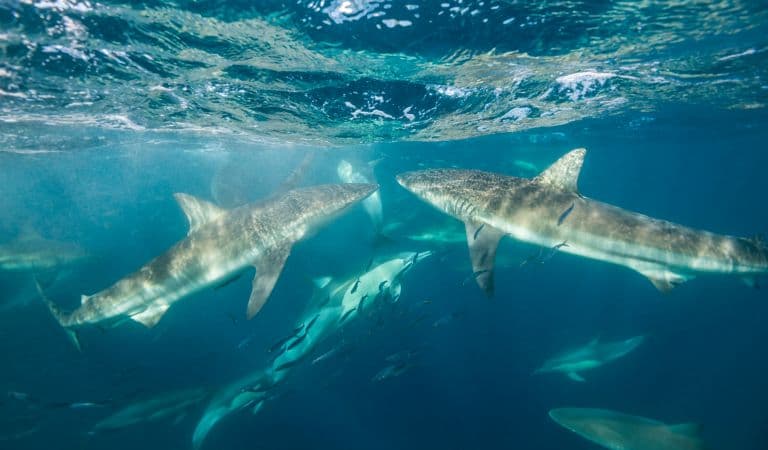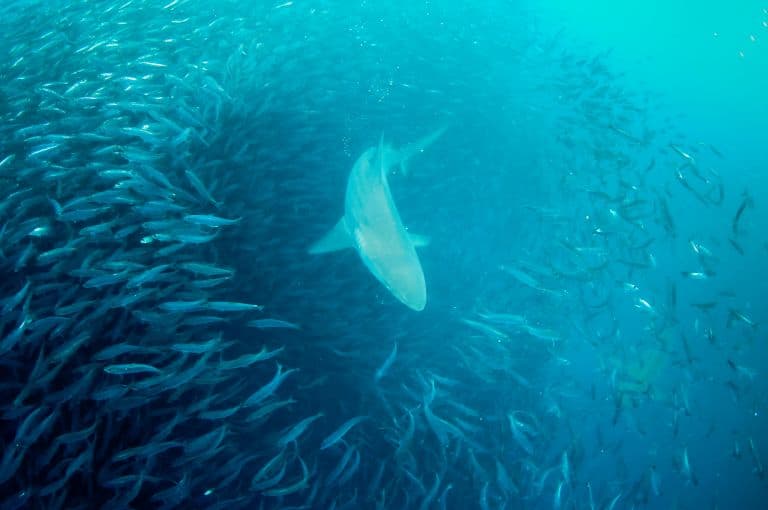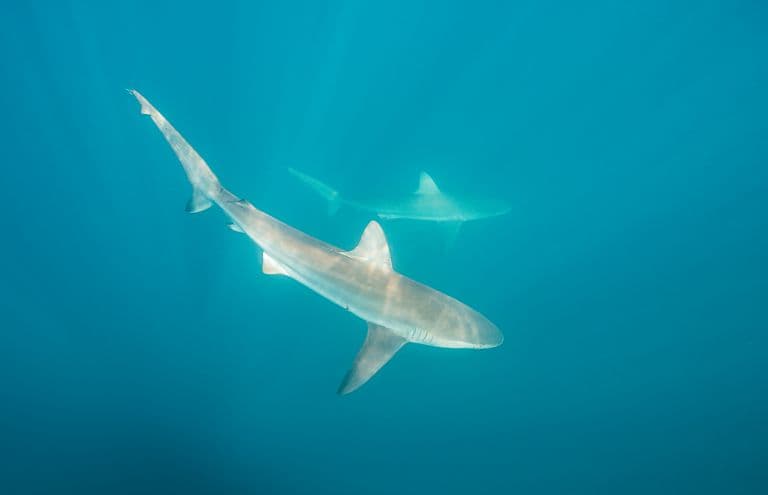Copper Shark Profile
In the distastefully named “Golden Age of Whaling”, whalers noted a species of shark that would gather in huge congregations to feed on the harpooned carcasses of the planet’s largest animals.
Sometimes numbering in their hundreds, these sharks would gather into a frenzy at the kill site, and show up in waters where no other shark like them lives.
They were given the name bronze whalers, on account of their metallic brown colouration. Today, they’re also known as narrowtooth or copper sharks.
Copper sharks are medium-sized, fast-swimming requiem sharks with a widespread distribution in cooler waters than you’d expect from the genus.

Copper Shark Facts Overview
| Habitat: | Temperate waters of coastlines and continental shelves |
| Location: | Worldwide |
| Lifespan: | Up to almost 35 years |
| Size: | Up to 2.5m long |
| Weight: | Up to 190 kg (420 lbs) |
| Colour: | Grayish-bronze on top, paler on the underside |
| Diet: | Fish: sharks, rays |
| Predators: | Larger sharks, orcas and humans |
| Top Speed: | Unkown |
| No. of Species: | 1 |
| Conservation Status: | Vulnerable (IUCN) |
Copper sharks occupy temperate latitudes, and can be found in brackish rivers, estuaries, harbours as well as offshore waters.
This approach keeps them out of competition with the bigger Charchariniformes and allows them to dominate shallows such as those found around New Zealand, South Africa and Argentina.
They feed on bony fish like hake and catfish, squid, octopus and cartilaginous fishes, such as dogfish sharks, sawfish and even stingrays and skates.
They’re sometimes solitary but will gather in huge numbers to exploit a large resource of food, or to find a mate. While their true population stats remain a bit muddled by misidentification, this species is vulnerable and likely in decline from overfishing.
Interesting Copper Shark Facts
1. They can handle the cold
These unusual requiem sharks show up in the fossil record from as far back as the Miocene, and they appear to be a close relative of the spinner shark, though their taxonomy hasn’t been fully teased out yet.
They’re the only member of the genus Carcharhinus that’s found in temperate waters – requiem sharks are usually a lot fussier about their bath water. This means they’re found in a lot of places you’d not expect to find such an awesome animal. 1

2. They’re very widespread
Able to tolerate cooler waters, this species is one of the most widely distributed in the genus. Copper sharks are found all over the world, between the Mediterranean, through the Atlantic Ocean, to the Eastern Pacific and Australian waters, too.
They do spend some time in the open ocean, but they generally stay near the surface, above 100m.
They’re the most common shark found in New Zealand, though the true range of this species is hard to determine on account of it being easy to mistake for others.
3. They’re adaptable
Being a shallow water specialist, the copper shark has evolved a tolerance to brackish waters, too. They’re seen in harbours, bays and estuaries, exhibiting an ability to move between waters of varying salinity.
4. They’re fast
It’s primarily a fish-eating predator, and huge gatherings of copper sharks will exploit the sardine run in South Africa and other similar schooling events around the world.
Their ability to dart into balls of fish at impressive speed is one of the ways they compete with their peers, and while this isn’t one of the largest requiem sharks, the species uses strength in numbers to its advantage. 2

5. They sometimes team up
Copper sharks can be both solitary or social, and groups of this species have been reported that number in the hundreds. When there’s a big feeding event to attend, copper sharks are known to team up to make the most of it.
Other times, breeding groups form, and these congregations are thought to be driven more by the temperature of the water than by prey availability. Still, despite being such a common shark, its reproduction is yet to be fully understood.
One thing we do know is that they age very slowly. 3
6. They’re long-lived
It’s thought that copper sharks can commonly live for at least 30 years in the wild. The highest recorded age was 34.5 years, which is pretty long for an active shark like this one.
But this longevity comes at a price, and maturity in this species takes around 20 years to reach, making them very slow to reproduce. Females select suitable nurseries to give birth, and the young mature and hatch inside the mother, emerging after a lengthy gestation of up to 21 months as a litter of 7 to 24 pups.
This reproduction happens only every other year, further reducing the rate of replacement for individuals who don’t make it this far.
7. Sadly, they are under threat
And sadly, many copper sharks are killed before they reach maturity. This is a target catch for fisheries, but it also comes up a lot as bycatch, so they’re reduced by various industrial fishing practices.
Longlines, gillnets and trawls are just a few of the methods fishing boats use to target their catch, and all of these bring up copper sharks on purpose or by accident.
Again, this species is often misidentified, so under-reporting of events like this is a serious problem that makes accurate record-keeping difficult, but for now, the species is listed as Vulnerable on the IUCN Red List.
This might not seem as serious as some other species, but their slow rate of reproduction makes them vulnerable to a rapid decline that could come seemingly out of the blue if conservation efforts don’t function as they should. 4

8. They can be dangerous
Human interactions on a more personal level are usually a lot more positive. This relatively small shark doesn’t see people as prey and being a common species, they’re popular with divers and snorkelers in temperate waters.
But they are fast and aggressive animals, and some attacks and even deaths have been reported, especially in places where they gather in large hunting groups.
Still, this is very rare, even by shark attack standards, with only one fatal unprovoked attack reported.
Copper Shark Fact-File Summary
Scientific Classification
| Kingdom: | Animalia |
| Phylum: | Chordata |
| Class: | Chondrychthyes |
| Order: | Charchariniformes |
| Family: | Charcharinidae |
| Genus: | Carcharhinus |
| Species: | Carcharhinus Brachyurus |
Fact Sources & References
- “Carcharhinus brachyurus Bronze”, Animal Diversity Web.
- Luis O. Lucifora (2005), “Reproduction and seasonal occurrence of the copper shark, Carcharhinus brachyurus, from north Patagonia, Argentina”, Oxford Academic.
- Marine Dynamics Shark & Whale Tours (2022), “Diving with Bronze Whaler sharks in South Africa”, YouTube.
- “Copper Shark”, IUCN Red List.
